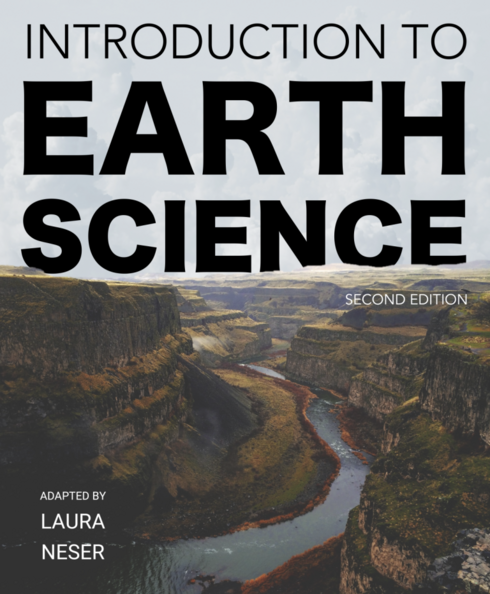
Introduction to Earth Science - Second edition
In DevelopmentLaura Neser, Virginia Tech
Estimated Publication: February 2025
Copyright Year:
ISBN 13: 978-1-962841-25-2
Publisher: Virginia Tech Publishing
Language: English
Formats Available
Conditions of Use
![]() Attribution-NonCommercial-ShareAlike
Attribution-NonCommercial-ShareAlike
CC BY-NC-SA
Table of Contents
1. Understanding Science
2. Plate Tectonics
3. Minerals
4. Igneous Processes and Volcanoes
5. Weathering, Erosion, and Sedimentary Rocks
6. Metamorphic Rocks
7. Geologic Time
8. Earth History
9. Crustal Deformation and Earthquakes
10. Mass Wasting
11. Water
12. Earth's Coastlines and Oceans
13. Deserts and Glaciers
14. Meteorology
15. Global Climate Change
16. Energy and Mineral Resources
17. Origin of the Universe and Our Solar System
Ancillary Material
Submit ancillary resourceAbout the Book
Introduction to Earth Science, Second Edition is an open textbook designed to provide a comprehensive introduction to Earth Science that can be freely accessed online, read offline, printed, or purchased as a print-on-demand book. It is intended for a typical 1000-level university introductory course in the Geosciences, although its contents could be applied to many other related courses.
This text includes various important features designed to enhance the student learning experience in introductory Earth Science courses. These include a multitude of high-quality figures and images within each chapter that help to clarify key concepts. Self-test assessment questions are embedded in each online chapter that help students focus their learning. QR codes are provided for each assessment to allow students using print or PDF versions to easily access the quiz from an internet-capable device of their choice.
The sequence of the book differs from mainstream commercial texts. It has been arranged to present elementary or foundational knowledge regarding rocks and minerals prior to discussion of more complex topics in Earth Science. Similar to the layout of the first edition, this book dedicates one chapter to each of the three major rock types, the processes of mass wasting, geological time, Earth history, and the origin of the universe and our Solar System. Additionally, the second edition includes a new chapter on meteorology, and combines the previously separate chapters on deserts and glaciers into a single, comprehensive chapter that explores these extreme environments.
The first edition of this book is available at: https://doi.org/10.21061/introearthscience.
Instructors reviewing, adopting, or adapting this textbook: please help us understand your use by filling out this form: https://bit.ly/interest_intro_earth_science.
About the Contributors
Author
Laura Neser, PhD, is an instructor in the Department of Geosciences at Virginia Tech. Dr. Neser earned her BS in Geosciences at Virginia Tech in the spring of 2008 and completed her PhD in Geological Sciences at the University of North Carolina at Chapel Hill (UNC) in 2014. Her doctoral research focused on the structural geology, sedimentology, and stratigraphy of formations that were deposited along the flanks of the Beartooth Mountains as they rose during the late Paleocene-Eocene time period. Since earning her PhD, Dr. Neser has worked as an athletic tutor and online instructor at the University of North Carolina at Chapel Hill, held temporary positions as an adjunct instructor at Chowan University (Murfreesboro, NC) and as a full-time lecturer at Indiana State University (Terre Haute, IN), and worked as a professor at Seminole State College (Sanford, FL) before joining Virginia Tech as an instructor in the fall of 2021.
Although she is currently focused on teaching sections of Introduction to Earth Science, Earth Resources, Society and the Environment, and Climate History, her teaching background is significantly broader and includes Sedimentology-Stratigraphy, Environmental Science, Astronomy, Environmental Ethics, Earth History, Structural Geology, and Field Geology.
